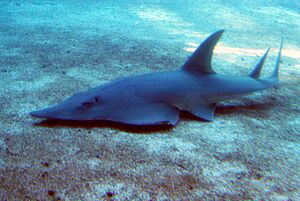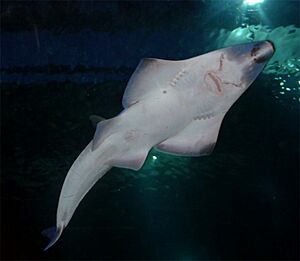Giant guitarfish facts for kids
Quick facts for kids Giant guitarfish |
|
|---|---|
 |
|
| Conservation status | |
| Scientific classification |
The giant guitarfish (Rhynchobatus djiddensis), also known as the whitespotted wedgefish, is a very large type of guitarfish. It belongs to the family Rhinidae. This amazing fish lives in the Red Sea, the Persian Gulf, and the western Indian Ocean. People used to think it lived in more places, but scientists found out it was often confused with its close relatives.
Contents
About the Giant Guitarfish
The giant guitarfish was once thought to live across a huge area, from the Indian Ocean to the Pacific. However, scientists later discovered that what they thought was one species was actually four different ones! These include the giant guitarfish itself, the white-spotted guitarfish, the broadnose wedgefish, and possibly the smoothnose wedgefish.
Because of this discovery, we now know the giant guitarfish has a smaller home range. It is found only in the Red Sea, the Persian Gulf, and the western Indian Ocean. You can find it as far south as South Africa. It's easy to mix up these different guitarfish species, especially since some of them live in similar areas.
What Does a Giant Guitarfish Look Like?
This is a really big fish! It can grow up to 3.1 m (10 ft) (about 10 feet) long and weigh as much as 227 kg (500 lb) (about 500 pounds). Its back is brownish or grayish, and it has white spots that can look different on each fish.
Young giant guitarfish have a black spot above each pectoral fin (the fins on their sides). As they get older, this spot might turn into a dark ring or disappear completely. They also have a dark, bar-like pattern between their eyes on top of their head. This helps tell them apart from other Rhynchobatus species in their habitat. You can also spot them by the large black eye-like spots near their pectoral fins and their distinct pointy snout.
People sometimes confuse the giant guitarfish with the common shovelnose ray. However, the giant guitarfish has a smaller first dorsal fin that sits further back on its body. Its head is more rounded with a noticeable snout, and it doesn't have indents in its upper jaw. It also has larger skin denticles, which are like tiny teeth on its skin.
Giant Guitarfish Behavior
Reproduction and Life Cycle
Giant guitarfish are considered ovoviviparous. This means their babies grow inside eggs within the mother's body. The embryos first get food from a yolk sac. Later, they get more food from a special fluid inside the mother.
These fish don't have many babies at once. On average, a female giant guitarfish only produces about four pups per litter. They usually give birth during the summer months.
What Do Giant Guitarfish Eat?
The giant guitarfish is a predator. It likes to eat bivalves (like clams), crabs, lobsters, squid, and small fish. Even though they don't have sharp cutting teeth, they are known to hunt stingrays! One giant guitarfish found in the Philippines had more than 20 stingray barbs stuck in its jaw. It seemed to be completely fine and not affected by the stingray's venom.
Where Do Giant Guitarfish Live?
The giant guitarfish is a shy fish. It lives in waters that are 2–50 m (6.6–164.0 ft) (about 6 to 164 feet) deep. They prefer areas with a sandy sea floor. You can usually find them around coastal reefs or flat reef areas. Sometimes, they will even swim into the slightly salty, brackish waters of estuaries.
Giant Guitarfish Population Status
Sadly, the number of giant guitarfish has dropped a lot. This is mainly because they are often caught by accident when people are fishing for other things. This has led to fewer fish, smaller populations, and even some areas where they have disappeared.
The giant guitarfish is listed as critically endangered on the IUCN Red List. This means it's at a very high risk of disappearing forever. It's hard to know the exact number of giant guitarfish left because there isn't enough specific data. It's also easy to confuse them with other similar species, which makes tracking their numbers difficult.
Even without exact numbers, we know their population is shrinking. Fishing rates remain steady or even increase. As more people live along coastlines, fishing technology gets better, and fish markets grow, more fishing happens worldwide. The biggest increases in fishing have been in Asia.
For example, a study in the Gulf of Thailand showed a 93% drop in catch rates for guitarfish and wedgefish species between 1968 and 1972. In Indonesia, a wedgefish fishery grew very fast but then declined sharply because too many fish were caught.
Data from Iran shows that landings of these fish dropped by 66% over 20 years. This suggests a huge population reduction. In Pakistan, data from two coastal areas showed drops of 72% and 81% in landings. This means the population has likely gone down by 98% to 99% over the last three generations.
In western India, catch rates for similar rays dropped by 63%. Since fishing efforts doubled, this suggests a 95% population reduction for guitarfish species. In eastern India, landings of guitarfish dropped by 86% in just a few years. In Indonesia, landings of whitespotted wedgefishes dropped by over 88% in a decade.
The only region where the giant guitarfish population might be more stable is Australia. Here, there isn't as much fishing, and there are more conservation efforts. Special devices called "turtle exclusion devices" are used in fishing nets. These devices help sea turtles escape, and they also help rays and guitarfish avoid being caught. They can reduce accidental catches by 94%. This means the giant guitarfish is still common in coastal waters of northern Australia.
However, fishing pressure is very high in most other places where this species lives. Even though Australia, Papua New Guinea, and the Solomon Islands protect the species, these areas are too small compared to the fish's global range. Overall, scientists believe the giant guitarfish population has dropped by more than 80% over the last three generations. This is why it is listed as critically endangered.
Threats to Giant Guitarfish
Giant guitarfish face a big threat from intense fishing. They live in coastal areas and on the continental shelf, where fishing is often not regulated. These fish are caught by many types of fisheries, including large industrial boats, smaller local fishing boats, and even people fishing for their own food.
They are caught using different methods like gillnets, trawling (dragging large nets), traditional hook and line, traps, and seine nets. After being caught, giant guitarfish are usually kept for their meat and their fins. There is a very high demand for shark and ray products, especially fins, which has increased fishing pressure.
Many countries in the Indo-West Pacific, like India and parts of Southeast Asia, have seen their coastal fish populations severely reduced. Fishing pressure is much lower in northern Australia.
The number of fishing boats and fishers has grown a lot in recent years. For example, in the Indian state of Gujarat, the number of trawlers increased from about 6,600 in the early 2000s to over 11,500 in 2010. India has a huge number of trawlers, totaling over 35,000. Many other countries also have large fishing fleets. Sri Lanka had 24,600 gillnet vessels in 2004, and Indonesia had about 600,000 fishing vessels. These numbers are likely even higher today.
Sharks and rays, including giant guitarfish, are often specifically targeted or caught by accident. The high value of their fins is a major reason why they are kept and traded globally. Several countries where the giant guitarfish lives are among the top 20 shark-fishing nations in the world. These include Indonesia, India, Malaysia, Taiwan, Thailand, and Sri Lanka.
Giant Guitarfish and Humans
General Information
The giant guitarfish is not dangerous to humans. However, it is listed as critically endangered on the IUCN Red List. This is because its population has dropped a lot due to too much fishing. People catch them for their meat and especially for their fins, which are used to make shark fin soup.
Even though removing fins at sea has been banned in some areas, the fins are still traded once the fish are brought to shore. Because these fish don't have many babies and grow slowly, they are very vulnerable to being overfished.
Fin Trade and Use
When giant guitarfish are caught, whether on purpose or by accident, fisheries keep them because their fins are valuable. Along the coasts where they live, local people eat the fish. But the dorsal (back) and caudal (tail) fins are often sold in the international shark fin trade.
Countries like China and other Asian communities have a very high demand for the fins of wedgefishes and giant guitarfish. Shark fin soup is a traditional dish often served for special occasions in Chinese culture. Besides food, wedgefishes and giant guitarfish are also sometimes used for traditional medicine. The fins can be very expensive, with some types selling for over US$964 per kilogram in places like Hong Kong.
Conservation Efforts
Right now, there are not many specific conservation efforts or rules in place just for the giant guitarfish. However, in Australia, the practice of "finning" (removing fins at sea) is now banned. Also, general rules for fisheries and protected marine areas in Australia will likely help the giant guitarfish population there.
Images for kids





